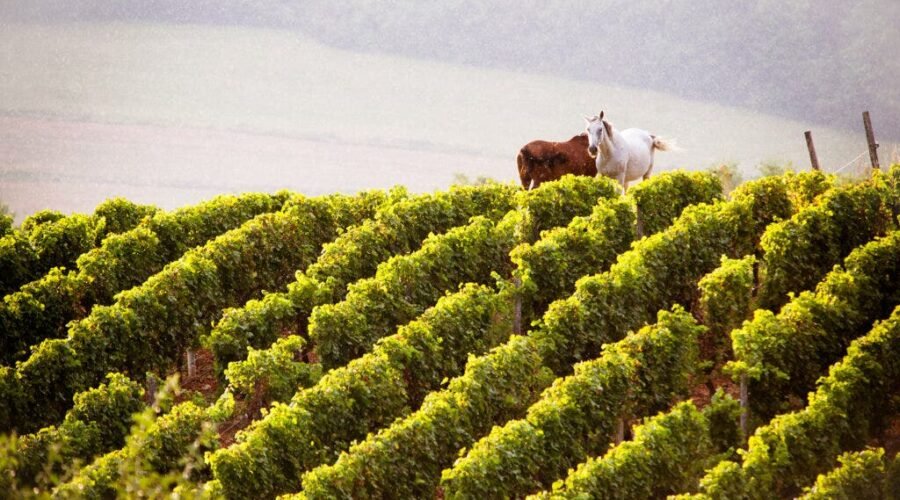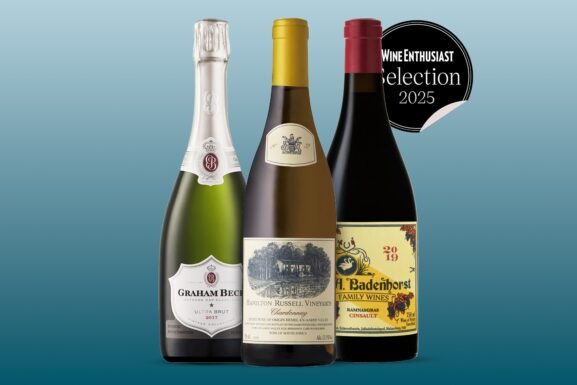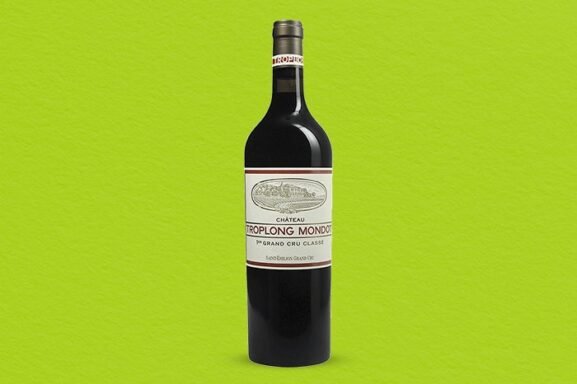Why Wine Geeks Are Obsessed with Jura
If German Riesling got me into wine, it was the Jura that made me change my career for it.
In 2010, I stumbled into what may have been New York’s first wine tasting devoted entirely to the Jura, that quiet, crumpled corner of eastern France. Everything I thought I knew about wine shifted.
I tasted whites aged oxidatively like Sherry but with none of the weight. They were brisk, elegant and alive. Reds as pale as rose petals and just as fragile. And natural wines that weren’t funky or loose, but sharp—like flint struck in a thunderstorm. These were wines that echoed white Burgundy but with more edge. I’d never imagined wine could be so exacting and unconventional at the same time.
The Rise and the Rumble
Over those past 15 years, Jura has gone from mere intrigue to a cult category. The rise wasn’t plotted. It just … happened. In a world where wine trends vanish as fast as gossip at a cocktail party, Jura has done something improbable: it’s endured. Not with flash, but with fervor.
It began, as these things often do, with a few visionaries and a lot of nerve.
When Brooklyn-based importer Zev Rovine started bringing Jura wines to the U.S. in 2008, it wasn’t because they were hot. They were almost laughably niche. “As a small start up, I was not able to compete in the famous regions,” Rovine remembers, “so I tried to find things that were distinct. The Jura had vin jaune, unknown grapes and the cool bottle,” the squat container called a clavelin. Most importantly, he says, “there were stories to tell—and people were captivated right away.”
// Create the element
var script_686c239fbc932 = document.createElement(“script”);
script_686c239fbc932.innerHTML = `
window.googletag = window.googletag || {cmd: []};
googletag.cmd.push(function() {
var adType = “leaderboard”;
var mapping;
var lbmapping = googletag.sizeMapping()
.addSize([1024, 0], [[970, 250], [970, 90], [1, 1], [728, 90]])
.addSize([728, 0], [[728, 90], [1, 1]])
.addSize([320, 0], [[1, 1], [300, 50], [300, 100], [320, 50], [320, 100]])
.addSize([0, 0], [[1, 1], [320, 50]])
.build();; // Size mapping for leaderboard ads
var medrecmapping = googletag.sizeMapping()
.addSize([1024, 0], [[300, 600],[300, 250]])
.addSize([728, 0], [300, 250])
.addSize([320, 0], [[1, 1],[300, 250]])
.addSize([0, 0], [[1, 1], [300, 250]])
.build(); // Size mapping for med rectengle ads
if(‘/39808611/article_page/article_leaderboard_1’ == ‘/39808611/article_page/article_leaderboard_1’
|| ‘/39808611/article_page/article_leaderboard_1’ == ‘/39808611/article_page/article_leaderboard_2’
|| ‘/39808611/article_page/article_leaderboard_1’ == ‘/39808611/article_page/article_leaderboard_3’) {
mapping = googletag.sizeMapping()
.addSize([1920, 0], [[728, 90]]) // >= 1920px
.addSize([1440, 0], [[728, 90]]) // 1440px-1919px
.addSize([730, 0], [[300, 250]]) // 730px-1439px
.addSize([0, 0], [[320, 100], [320, 50], [300, 100], [300, 50], [300, 250]]) // Up to 729px
.build();
} else {
mapping = adType == ‘leaderboard’ ? lbmapping : medrecmapping;
}
googletag.defineSlot(‘/39808611/article_page/article_leaderboard_1’, [],
‘div-gpt-ad-686c239fbc932’).addService(googletag.pubads()).defineSizeMapping(mapping);
googletag.pubads().enableSingleRequest();
googletag.pubads().collapseEmptyDivs();
googletag.display(‘div-gpt-ad-686c239fbc932’);
});
`;
// Append the script to the body
document.body.appendChild(script_686c239fbc932);
Around the same time, sommelier Jorge Riera, who is now wine director of the entire Frenchette restaurant group, was pouring Houillon-Overnoy, one of the most sought-after, cult Jura wines, by the glass at 360 in Brooklyn. Today that reads like a flex; back then, it was closer to a dare.
“A lot of the somms thought PlouPlou [a k a Poulsard] lacked flavor,” Riera recalls. “So when [the late] Joe Dressner said they couldn’t move the wines, we jumped.” (Dressner was the founder of the legendary Louis/Dressner Selections.)
Soon, la Dive Bouteille, a monumental natural wine fair in Loire Valley with many spin-offs of wine fairs, exposed a generation of wine lovers to Jura’s iconoclasts—Houillon-Overnoy, Ganevat, Bornard, Brignot, Tournelle, Labet—and a new wave of producers with wild labels and even wilder ideas, from radical regenerative farming practices to extended skin-contact in whites. People returned from trips with stars in their eyes and Savagnin on their breath.
A Tradition of Rebellion
Let’s be clear: Jura is not new to greatness. Arbois, its most famous appellation, became an AOC in 1936—one of France’s first. Long before Instagram fetishized amber hues and smoky Poulsards, Jura was quietly making wines of astonishing depth. What we’re witnessing isn’t a discovery, but a resurgence.
In Jura, “tradition” is not a buzzword—it’s a worn groove. Many white wines are aged under a thin film of yeast called “voile,” which invites oxygen into the barrel. The result is transformative: nutty, salty, ancient.
Though this technique famously used for vin jaune is now intentional, local lore claims it emerged by accident. Legend has it a winemaker forgot a barrel in his cellar and found it covered with this film. Since he needed wine, he tried it and discovered its unique taste profile. Whether this is actually true or not, one thing is certain: the style stuck.
And yet even here, things change. Some winemakers began “ouillé”—topping up their barrels to keep oxygen out and vibrancy in. Anywhere else, that would be the norm. In Jura, it was practically punk. It made wine reductive, rather than oxidative. These wines smell like struck matches and smoky flint with bright citrus and orchard fruit notes, instead of toasted almonds and dried fruit in their raisin-y predecessors.
The reds—Poulsard, Trousseau, Pinot Noir—have long been misunderstood. “Too pale!” “Too light!” “Too weird!” Those were just a few of the critiques I heard from my drinking companions.
But what some dismissed as glorified rosé turned out to be something far more soulful: delicate reds with quiet energy, bright acidity and subtle aromas of wild berries and forest floor. Wines that shimmer with transparency, revealing every nuance of their unique cool and wet, limestone-marked terroir. And while the whites may still be the stars of the show, the reds often walk away with Best Supporting Actor.
Jurassic Magic
So what is it about Jura that sparks such obsession?
Partly, it’s the scarcity. Partly, it’s the taste. Rovine points to the whites’ salinity—“hard to find elsewhere,” he says—a product of terroir, microflora and a cool climate that feels increasingly rare in our warming world. But it’s also the culture. “The natural wine movement and Jura’s rise happened in concert,” he adds.
More than that, it felt grassroots. Jura wasn’t pushed on anyone. It was passed from hand to hand—between importers, somms, guests who didn’t flinch at sharp, tangy volatility acidity or the bold punch of oxidative notes. “The Jura consumer is someone searching for a new taste,” says Rovine. “It’s kinda the essence of being a wine fan.”
When working the floor, Riera found Jura wines resonated with a particular type of guest. “It was just someone that was open minded and with a palette, someone looking for more gourmand wines, savory and lip smacking flavors,” he says.
The region doesn’t perform for anyone. It’s just what it is. And that’s why it’s garnered a growing slew of devoted fans.
Friction and Future
Of course, popularity brings its own problems. Allocations have shrunk, prices have soared and the secondary market is ravenous for more. But Rovine sees the upside: “The prices from the wineries are more than double what I used to pay, but I think that’s a relatively good thing. People are willing to pay a lot for the wines, so I’m happy to see the winemakers raising their prices as they are far from rich and a little more financial security is a good thing, especially in a region so prone to frost and other disease pressure.”
That newfound sense of financial security has made space for new voices.
Some, like Maison Maenad’s Katie Worobeck or Alexandre Plassat and Nicolas Jacob, carry the original punk ethos forward. Others are second-career arrivals who are more interested in connecting with the land than lineage and tradition. They are more committed to embracing a sustainable, agrarian approach. Jura’s small-scale and rural environment offers a perfect canvas for this viticulture ethos.
“Radical producers aren’t always young,” Rovine notes. “Wine—especially Jura—is a counter-current to people leaving the countryside. These folks are coming back.”
// Create the element
var script_686c239fbd416 = document.createElement(“script”);
script_686c239fbd416.innerHTML = `
window.googletag = window.googletag || {cmd: []};
googletag.cmd.push(function() {
var adType = “leaderboard”;
var mapping;
var lbmapping = googletag.sizeMapping()
.addSize([1024, 0], [[970, 250], [970, 90], [1, 1], [728, 90]])
.addSize([728, 0], [[728, 90], [1, 1]])
.addSize([320, 0], [[1, 1], [300, 50], [300, 100], [320, 50], [320, 100]])
.addSize([0, 0], [[1, 1], [320, 50]])
.build();; // Size mapping for leaderboard ads
var medrecmapping = googletag.sizeMapping()
.addSize([1024, 0], [[300, 600],[300, 250]])
.addSize([728, 0], [300, 250])
.addSize([320, 0], [[1, 1],[300, 250]])
.addSize([0, 0], [[1, 1], [300, 250]])
.build(); // Size mapping for med rectengle ads
if(‘/39808611/article_page/article_leaderboard_2’ == ‘/39808611/article_page/article_leaderboard_1’
|| ‘/39808611/article_page/article_leaderboard_2’ == ‘/39808611/article_page/article_leaderboard_2’
|| ‘/39808611/article_page/article_leaderboard_2’ == ‘/39808611/article_page/article_leaderboard_3’) {
mapping = googletag.sizeMapping()
.addSize([1920, 0], [[728, 90]]) // >= 1920px
.addSize([1440, 0], [[728, 90]]) // 1440px-1919px
.addSize([730, 0], [[300, 250]]) // 730px-1439px
.addSize([0, 0], [[320, 100], [320, 50], [300, 100], [300, 50], [300, 250]]) // Up to 729px
.build();
} else {
mapping = adType == ‘leaderboard’ ? lbmapping : medrecmapping;
}
googletag.defineSlot(‘/39808611/article_page/article_leaderboard_2’, [],
‘div-gpt-ad-686c239fbd416’).addService(googletag.pubads()).defineSizeMapping(mapping);
googletag.pubads().enableSingleRequest();
googletag.pubads().collapseEmptyDivs();
googletag.display(‘div-gpt-ad-686c239fbd416’);
});
`;
// Append the script to the body
document.body.appendChild(script_686c239fbd416);
Riera believes that while the price increase has been good for the region, it’s also been challenging: “The scarcity and high demand are tough when production is so small—especially after these last few difficult years of climate change.”
As a result, a few producers—like Valentin Morel and Didier Grappe—have begun working with hybrid grapes, like Le Rayon d’Or, Plantet, Seyve-Villard, Souvignier Gris and Sauvignac, which are more resilient in the face of climate challenges such as higher temperatures and humidity that can lead to fungal diseases.
These pressures have become increasingly common in similar continental climates. Despite many wine drinker’s perception that Jura is an Alpine region, like nearby Savoie, it is not. Most of its vineyards sit at similar altitudes to the Côte d’Or in hilly Burgundy, at around 200 to 400 meters (650 to 1,350 feet).
The climate isn’t the only Jura myth.
The oxidative style, while iconic, isn’t universal. A new generation favors freshness and precision, wines with snap and crystalline lift.
And, yes, many producers work organically or biodynamically. But this isn’t some curated natty wine fantasy. For most, it’s been an inability to invest in the conventional sprays and modern machinery that other, wealthier regions were able to turn toward. Here, sustainable practices hail from wisdom passed down in muddy boots as a means of survival, not marketing.
Jura’s Quiet Excellence
To love Jura is to let go of the myth and embrace the contradiction. It is humble and defiant, weathered and wild, at times elegant and highly in demand.
The wines of Domaine des Cavarodes or Buronfosse, for example, feel less like products and more like messages: raw, expressive, sometimes unruly. Ganevat’s wines, on the other hand, show incredible finesse. Bottles from Overnoy, Bruyere-Houillon or Kagami blur the line between art and instinct—impossible to pin down, rewarding when they land—rare, highly sought-after collectibles.
In the end, Jura is just a wine region. It’s not waiting to be discovered—it simply carries on, on its own terms. Still, wines always taste better when they create lingering memories, the stuff that lives on a la the Proust effect. And Jura, with its quiet charm and long rustic aftertaste, might just be the perfect canvas.
Here are some of my favorite bottles right now.
Sous Voile (Oxidized)

Domaine de la Borde Arbois Pupillin Vin Jaune 2013
$79
Somm Picks

Domaine de la Tournelle Savagnin de Voile 2016
$80
Troy Wine Co.

Domaine de la Touraize Arbois Vin Jaune 2016
$105
Some Good Wine

Jacques Puffeney Arbois Vin Jaune 2014
$219
Kogod Wine Merchant
Ouillé (Topped up)

Benedicte et Stephane Tissot Ouille Savagnin 2020
$65
Wine Solutions

Domaine de Saint Pierre Arbois Savagnin Ouille 2020
$72
Somm Picks

Domaine la Grapp’A Cotes du Jura Savagnin Ouille 2022
$75
Wine-searcher

Domaine des Cavarodes Chardonnay 2020 (Cotes du Jura)
$65
Somm Picks
The OG’s

Jean-Francois Ganevat Cotes du Jura Trousseau Plein Sud 2023
$132
SF Wine Trading Co.

Emmanuel Houillon (Maison Pierre Overnoy Chardonnay Arbois Pupillin 2023
$489
Somm Picks

Philippe Bornard & Albert Ponnell Les Viandris Chardonnay Arbois Pupillin 2022
$69
Thatcher’s Wine

Domaine Labet Chardonnay Les Varrons
$110
Plucky Wines

Domaine Buronfosse Indigene Cremant Du Jura 2022
$40
Discovery Wines
The New Guard

Nicolas Jacob Cotes du Jura Le Clos 2019
$149
Somm Picks

Domaine des Miroirs Vin De Francem Mon rythme Son rythme
$1,099
Somm Picks

Renaud Bruyere & Adeline Houillon Ploussard Arbois Pupillin 2018
$300
The Chicago Wine Company
More French Wine Coverage
- Under-hyped and overdelivering, Savoie showcases rare grapes.
- These top-rated bottles show off the opulence of Alsatian Pinot Gris.
- Get to know the under-the-radar world of grower Champagne.
- And by the way: Great Champagne doesn’t need to cost more than $100.
- Have Burgundy taste on a beer budget? These excellent Burgundy wines are actually affordable.

From the Shop
Find Your Wine a Home
Our selection of white wine glasses is the best way to enjoy the wine’s subtle aromas and bright flavors.
The post Why Wine Geeks Are Obsessed with Jura appeared first on Wine Enthusiast.


